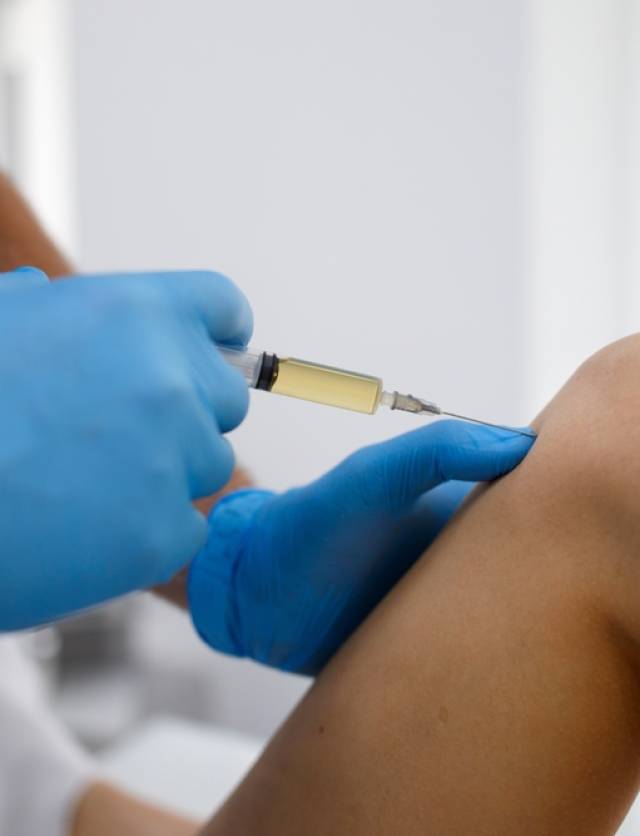Joint Injections
Joint injections are a therapeutic treatment that involves administering medication directly into a joint. These injections can address a wide range of conditions, such as osteoarthritis, rheumatoid arthritis, and gout. While they can be performed on various joints throughout the body, the most common areas include the knees, hips, back, neck, and shoulders. There are several types of joint injections, each serving a specific purpose:

Corticosteroid Injections:
Corticosteroid injections are the most commonly used type of joint injection. They effectively reduce pain and inflammation associated with various arthritis types. Corticosteroids are potent anti-inflammatory medications that provide significant relief.
Hyaluronic Acid Injections:
When corticosteroid injections no longer provide sufficient relief, hyaluronic acid injections are an option for treating osteoarthritis, particularly in the knee. Hyaluronic acid is naturally present in the body and helps lubricate and cushion the joints, making it ideal for promoting joint function and reducing pain.
Platelet-Rich Plasma (PRP) Injections:
PRP injections are used to treat conditions like tendinitis and arthritis. These injections contain a concentrated dose of platelets, which play a vital role in blood clotting and tissue healing. When injected into a joint, PRP helps reduce inflammation and promotes the body’s natural healing processes.
Did You Know?
Up to 30 million Americans experience joint pain in some form. Although joint pain can occur in any part of the body, the knees, hips, fingers, and shoulders are the most commonly affected areas.
Frequently Asked Questions:
Am I a candidate for joint injections?
If your pain is directly related to joint inflammation, you may be a candidate for joint injections. These injections are generally safe and effective for most people. However, there are some risks involved. It’s important to discuss the potential risks and benefits with your doctor to determine if joint injections are appropriate for you.
What can I expect when getting a joint injection?
On the day of your appointment, you will be asked to remove any clothing or jewelry around the injection site. You will then lie down on a bed or table. The injection site will be cleaned with an antiseptic, and a local anesthetic may be used to numb the area. An ultrasound might be used to visualize the joint. After the area is numb, your doctor will insert a needle into the joint and inject the medication. In some cases, fluid build-up may be removed before the medication is injected. You may feel a brief sting as the needle is inserted. After the injection, you will remain still for a few minutes to allow the medication to be absorbed.
What can I expect after a joint injection?
Most people experience relief from pain and inflammation within a few days of the injection, although the full effects may take up to a week. In the meantime, you can use ice, NSAIDs, or Tylenol for pain relief. It’s recommended to avoid strenuous activities or heavy lifting for at least 48 hours after the injection. Be sure to follow your doctor’s instructions for caring for the injection site. If you have any concerns, don’t hesitate to contact your doctor.
Some of the Joint Injections Offered at Cellara Pain Institute:
Shoulder Joint Injections
An outpatient procedure designed to relieve shoulder and arm pain caused by arthritis, injury, or disorder.
Steroid Injection for Shoulder Bursitis
Subacromial Joint Injection
Used for conditions such as adhesive capsulitis, sub-deltoid bursitis, impingement syndrome, and rotator cuff tendinosis.
Knee Joint Injection
A non-operative, outpatient procedure for relieving knee arthritis pain. This technique allows for maximum accuracy when injecting an inflammation-reducing steroid.
Hip Joint Injection
If you’re experiencing hip pain, your doctor may inject medication into the hip joint. This can both identify the source of your pain and provide relief.
Sacroiliac Joint Steroid Injection
This procedure helps relieve pain caused by arthritis in the sacroiliac joint, where the spine meets the hip bone. Steroid medication can reduce swelling and inflammation in the joint.
